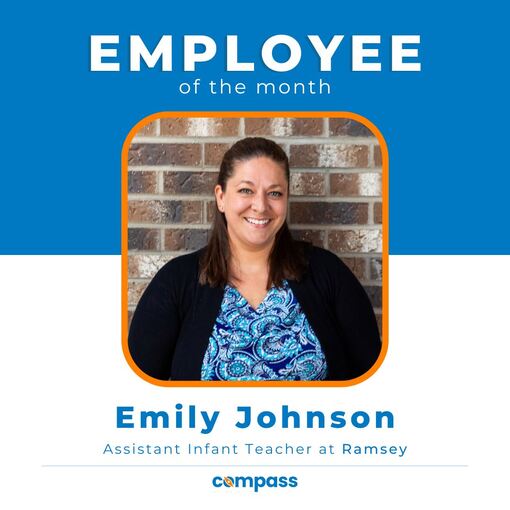A Community Event Filled with Laughter, Creativity, and Treats Last Friday, the vibrant community of Ramsey, MN, was aglow with more than just autumn's amber hues – it was illuminated by the delightful spirit of Compass Childcare's Trunk-or-Treat event! 🎃🚗 A Night to Remember In the heart of Ramsey, an extraordinary evening unfolded. Families gathered, smiles were shared, and a parade of creatively decorated trunks opened their treasures to the excited crowd. This wasn't just an event; it was a celebration of community, creativity, and of course, the joy of childhood. Creativity Unleashed The trunks - oh, the trunks! Each one was a canvas, showcasing the imaginative prowess of our participants. From spooky spectacles to whimsical wonderlands, the variety was as vast as the creativity that our Ramsey community is known for. It was a testament to the spirit of Compass Childcare, where imagination and play are at the heart of learning. Laughter and Community Amidst the sea of costumes and candy, laughter was the evening's melody. Parents, children, and the Compass Childcare team bonded over shared experiences, creating memories that would linger long after the last piece of candy was given away. It's moments like these that reinforce our commitment to nurturing not just children, but families and our community. More Than Just Candy Yes, there was candy - plenty of it! But more importantly, there was a sense of belonging. As a leading childcare provider in Ramsey, Compass Childcare is more than a place for exceptional early education. We are a hub for community engagement, a space where families come together, celebrating milestones and everyday joys. Looking Ahead As we look back on this enchanting evening, we are already buzzing with excitement for what's next. Compass Childcare is committed to being an integral part of Ramsey's fabric, fostering environments where children thrive and communities flourish. Join the Compass Family Are you looking for a childcare solution that blends top-notch education with a deep sense of community? Compass Childcare in Ramsey is the answer. We invite you to visit us, see our approach in action, and become part of a family that values growth, learning, and the sweet moments that make childhood magical. Come be a part of our journey. Together, we're making Ramsey not just a place to live, but a place to thrive.  In the cozy town of Ramsey, Minnesota, where childhood is nurtured and treasured, we at Compass Childcare have the joy of celebrating a very special member of our family – Ms. Emily, our October Employee of the Month! 🧡💙 A Journey of Passion and Care Emily's journey in child care has been nothing short of remarkable. As a mentor and a guiding light, she has been an integral part of our Compass Childcare team from the very beginning. Her story is one that intertwines with many of ours, including mine. I vividly remember Emily as one of my first peers in this fulfilling career, imparting her wisdom and passion for child care. Her influence extends beyond the professional realm, touching personal lives – she was there to help potty train my son and tenderly cared for my baby girl. More Than a Caregiver: A Source of Joy and Learning Emily's approach to child care is a beautiful blend of compassion, patience, and love. She has this unique ability to connect with each child, making them feel seen and cherished. It's not just the children in her own classroom who adore her; her warmth radiates throughout our center, touching the hearts of all the children she encounters. One of the most enchanting aspects of Emily's personality is her love for all things nature, especially bugs! While her fascination with the creepy crawlies might send a shiver down some spines, it's a treasure trove of learning and fun for the children. During our bug and garden units, Emily's expertise and enthusiasm bring these topics to life, sparking curiosity and wonder in our young learners. A Little Mischief Goes a Long Way But there's more to Emily than her educational skills. Her playful spirit keeps us all on our toes! From her tiny plastic spiders that might greet you unexpectedly to her delightful tricks, Emily infuses joy and laughter into our days at Compass Childcare. An Integral Part of Our Family We are incredibly fortunate to have Emily as part of our Ramsey family. Her dedication to child care and her ability to spread love and joy are what make Compass Childcare not just a place to learn, but a home to grow. As we celebrate her this month, we're reminded of the significant impact one individual can have on the lives of many. Emily, we cherish you, we thank you, and we love you! Join us at Compass Childcare in Ramsey, MN, where we not only nurture the minds of our little ones but also celebrate the incredible people who make this journey possible. Visit us to experience the love and learning that Emily and our team bring to every child's day.
Discovering the Wonders of Turtles, Frogs, and Creepy Crawlers this week at Compass Child Care7/18/2023
 This week we are learning about the United States of America! We have been busy learning about the history of the United States. Through making American flags, firecracker art, tye-dyed shirts, music, and a myriad of learning activities we’re discovering the country we love and live in. United States of America Learning Objectives: X Expressing through art, song, and music. X Using symbols to understand the USA. X Learn how the past relates to the present. X Build phonemic awareness. X Show confidence & positive self-image. X Use fine motor skills with increasing complexity (cutting strips of paper to create our flag, for example). We hope everyone has a safe and happy Fourth of July. We will be closed, so see you on Wednesday the 5th! WEEKLY RECAP - Nutrition
This week we are learning about Nutrition! In Science we’re discovering that grapes grow on vines and what would happen if they remained on the vine and the sun baked them for a long time. We also learned about vegetables, grains, and dairy products! Nutrition Learning Objectives: X That nutrition is a cultural & health related topic X Answer questions that require a complex response X Increased vocabulary use X Retell a simple story in the correct sequence X Understanding how nutrition keeps our bodies healthy, strong and feeling good physically Next week we start a new monthly theme.... Ocean Commotion!! The month starts off with learning about the Sea Environment!  Parent Aware, Minnesota’s Quality Rating and Improvement System, offers tools and resources to help:
Quality starts with you, your child and Parent Aware. Our Learn section is a great place to find articles and guides that will assist you in your search. You can also begin your search now, either online or by calling Parent Aware at 888.291.9811. Parent Aware is engaging in an ongoing project to address equity issues in the program. |
AuthorWrite something about yourself. No need to be fancy, just an overview. Archives
June 2024
Categories
All
|
